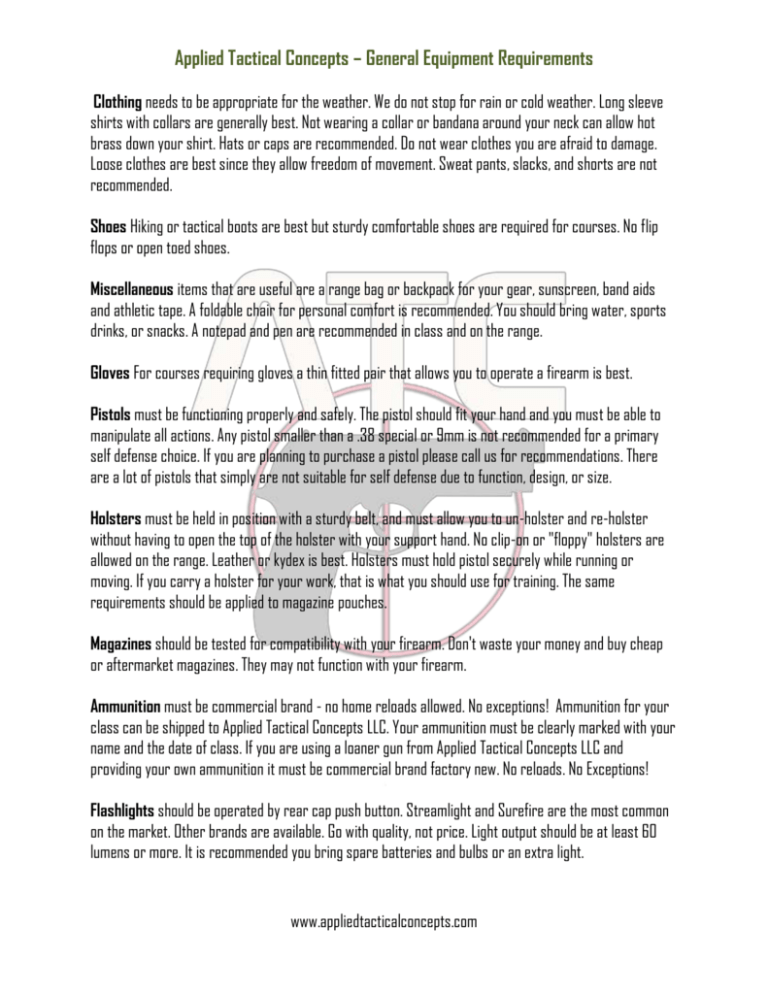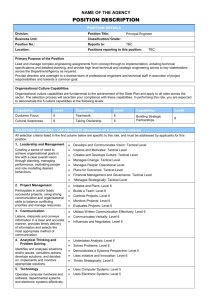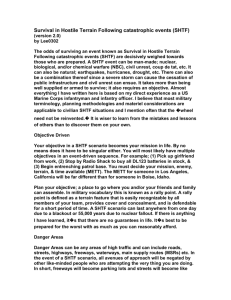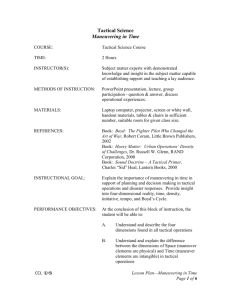Please check our General Equipment Requirements for these
advertisement

Applied Tactical Concepts – General Equipment Requirements Clothing needs to be appropriate for the weather. We do not stop for rain or cold weather. Long sleeve shirts with collars are generally best. Not wearing a collar or bandana around your neck can allow hot brass down your shirt. Hats or caps are recommended. Do not wear clothes you are afraid to damage. Loose clothes are best since they allow freedom of movement. Sweat pants, slacks, and shorts are not recommended. Shoes Hiking or tactical boots are best but sturdy comfortable shoes are required for courses. No flip flops or open toed shoes. Miscellaneous items that are useful are a range bag or backpack for your gear, sunscreen, band aids and athletic tape. A foldable chair for personal comfort is recommended. You should bring water, sports drinks, or snacks. A notepad and pen are recommended in class and on the range. Gloves For courses requiring gloves a thin fitted pair that allows you to operate a firearm is best. Pistols must be functioning properly and safely. The pistol should fit your hand and you must be able to manipulate all actions. Any pistol smaller than a .38 special or 9mm is not recommended for a primary self defense choice. If you are planning to purchase a pistol please call us for recommendations. There are a lot of pistols that simply are not suitable for self defense due to function, design, or size. Holsters must be held in position with a sturdy belt, and must allow you to un-holster and re-holster without having to open the top of the holster with your support hand. No clip-on or "floppy" holsters are allowed on the range. Leather or kydex is best. Holsters must hold pistol securely while running or moving. If you carry a holster for your work, that is what you should use for training. The same requirements should be applied to magazine pouches. Magazines should be tested for compatibility with your firearm. Don't waste your money and buy cheap or aftermarket magazines. They may not function with your firearm. Ammunition must be commercial brand - no home reloads allowed. No exceptions! Ammunition for your class can be shipped to Applied Tactical Concepts LLC. Your ammunition must be clearly marked with your name and the date of class. If you are using a loaner gun from Applied Tactical Concepts LLC and providing your own ammunition it must be commercial brand factory new. No reloads. No Exceptions! Flashlights should be operated by rear cap push button. Streamlight and Surefire are the most common on the market. Other brands are available. Go with quality, not price. Light output should be at least 60 lumens or more. It is recommended you bring spare batteries and bulbs or an extra light. www.appliedtacticalconcepts.com Applied Tactical Concepts – General Equipment Requirements Elbow and knee pads can be purchased at Home Depot, Lowes, hardware stores, skate shops, and from tactical suppliers. Our ranges are rocky so these items are required for most courses. Precision Rifles in a .308 caliber are most common but many other options are suitable. For optics something with a 3-10 power magnification is best. Rifles should be outfitted with a shooting sling. Lightweight rifles are acceptable; long heavy barreled rifles do get heavy during the class. Harris bipods are suggested for use in the courses but a backpack can serve as a shooting rest. A rear pad on the stock may be required to obtain proper cheek weld; this is essential to shooting consistently and accurately. Carbines with 16 inch barrels are generally best. Iron sights or optics are acceptable. A simple carry sling is recommended for general purposes. Please call with any questions concerning carbine configurations. Tactical Gear If you wear specific gear for your job it is recommended that you train with that equipment. If you are training for self defense you should train with the equipment you are likely to have with you. For example it doesn't make sense to train with a tactical vest if you only wear it to the range. In other words you should train like you will fight, nothing more, and sometimes less, just to prepare for everyday life that turns into worst case scenarios. If you are attending a class for the first time, don't spend a lot of money on gear that may not work. Part of training is learning about the equipment and what works best. If you have any questions please don't hesitate to contact us. There is not much worse than attending a class and not getting the full benefit of instruction due to personal equipment issues. www.appliedtacticalconcepts.com











